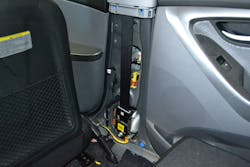University of Extrication: Seatbelt Pretensioner Components
SUBJECT: Pretensioner Systems
TOPIC: Seatbelt Pretensioner Components
OBJECTIVE: Recognition of Seatbelt Pretensioner System Components
TASK: Given an acquired late-model vehicle, the rescue team shall locate and identify seatbelt pretensioner system components on the B-pillar of the vehicle
This University of Extrication article is designed to improve the ability of rescue personnel to recognize the most common type of seatbelt pretensioner system and better understand the operation of its components. Having a better understanding of these systems and being able to recognize them quickly will improve the efficiency of any rescue task being done when working with the B-pillar of a crash-damaged vehicle.
It has become common for vehicle rescue personnel to perform extrication tasks that involve cutting into or around the B-pillar of a vehicle. Tasks such as B-pillar removal when working a side impact or something more involved such as total sidewall removal can place rescue teams close to any seatbelt pretensioner components located inside or mounted onto the B-pillar.
For a rescue crew cutting into the B-pillar during a rescue task, the most common pretensioner component is a seatbelt recoiler unit along with its activation device. The recommendation is made that anytime a B-pillar is being cut, the inner pillar trim should have already been removed. This provides a heads-up as to if this style recoiler is present and exactly where it is located. Knowing it is there can allow the tool operator cutting through a pillar to cut above the unit and avoid all the hassle of working with that unit at all. Pillars don’t have to be cut off even with the rocker; they just have to be cut lower than the front seat cushion level.
Within the seatbelt recoiler unit is an internal firing system. In this image, it is the small cylinder-shaped component that the yellow plug is connected to. It contains a black powder element that when zapped with electricity, will fire off and spin the recoiler spool. This results in the seatbelt webbing being pulled back as slack is removed from the seatbelt around the belted occupant.
The recoiler and firing device unit is somewhat durable although this author had an instance with a Volvo sedan where the vibration of a reciprocating saw cutting through the B-pillar caused the pretensioner to fire off. Other than a loud bang if this unit accidentally deploys during extrication work, the only real hazard will be potential movement of the seatbelt webbing itself. For this reason, it may be best if the seatbelt webbing is not only unbuckled from the patient but is physically cut in two prior to a pillar being cut through.
If a rescuer observes other small units mounted higher up on the inside of the B-pillar, these are most likely crash sensors such as the one shown. Again, the color yellow is the most common color used to identify these components. During a collision, these devices send the signal to the airbag brain. The presence of a crash sensor on the B-pillar reinforces why electrical system shutdown should have been accomplished long before any cutting into the B-pillar is undertaken. We want to minimize the possibility of any accidental pretensioner or airbag deployments during our extrication work.
TASK: Given an acquired late-model vehicle, the rescue team shall locate and identify seatbelt pretensioner system components on the B-pillar of the vehicle
Gray box sidebar:
Seatbelt Pretensioner Safety Considerations
- Ensure 12-volt power is shut down
- Strip away B-pillar inner trim piece
- Identify seatbelt pretensioner location
- Cut across B-pillar above recoiler unit
- Cover sharps

Ron Moore
RON MOORE, who is a Firehouse contributing editor, recently retired as a division chief with the McKinney, TX, Fire Department and now serves with Prosper, TX, Fire Rescue. He self-published the Vehicle Rescue 1-2-3 training manual and serves as the forum moderator for the extrication section of Firehouse.com . Moore can be contacted directly at [email protected].






